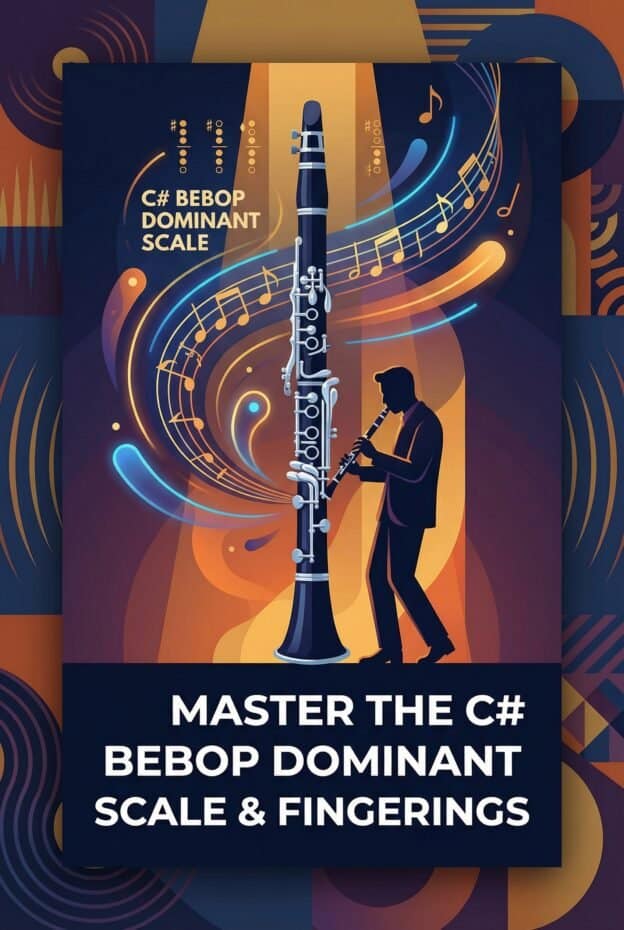When we talk about the C# Bebop Dominant Scale, we're not just discussing a simple set of notes. This scale has been instrumental in shaping musical innovations, especially in clarinet music. It's brought a distinctive flavor that's inspired countless artists over time. Jazz clarinetists, in particular, have embraced this scale as a foundation for improvisation, adding richness to the musical landscape with each note they play.

Clarinet Fingering Charts are always FREE at MartinFreres.net!
The Origins of Bebop and the C# Dominant Scale
To truly grasp its importance, let's take a step back in time. ‘Bebop' emerged after World War II, ushering in a jazz style known for its intricate harmonies and quick tempos. Musicians craved complexity, seeking something different from the predictable patterns of earlier jazz forms. The C# Bebop Dominant Scale, with its unique intervals, became a go-to for these musicians, sparking their creativity and propelling the jazz movement forward.
What Makes the C# Bebop Dominant Scale Special?
At its heart, the C# Bebop Dominant Scale combines major and minor elements, creating an exciting tension that encourages musicians to experiment. It's essentially a mixolydian scale with an extra chromatic note, bridging the gap between traditional and modern sounds. This chromaticism adds depth to the harmonic structure, giving clarinetists a broader range of expression in their music.
| Scale Degree | Note | Interval |
|---|---|---|
| 1 | C# | Root |
| 2 | D# | Major 2nd |
| 3 | E# | Major 3rd |
| 4 | F# | Perfect 4th |
| 5 | G# | Perfect 5th |
| 6 | A# | Major 6th |
| 7 | B | Minor 7th |
| 8 | C | Chromatic Passing Tone |
The Scale's Impact on Jazz Improvisation
The rich textures of this scale have shaped the art of melodic improvisation. Notable clarinetists like Benny Goodman and Jimmy Giuffre used the C# Bebop Dominant Scale extensively, influencing the direction of jazz. Listen to their recordings, and you'll hear how they skillfully use this scale, creating solos full of color and emotion.
Embracing the Learning Curve
New clarinetists might find the C# Bebop Dominant Scale a bit daunting at first. It's natural to wonder, ‘Why all the excitement?' But experienced players know that the magic isn't just in the scale itself – it's in how it opens up new avenues for improvisation and personal expression. Don't worry if it seems challenging initially. Take your time, practice each note, and before you know it, you'll be flowing through the intervals effortlessly.
Why This Scale Matters in Jazz
Working with this scale is key to grasping fundamental jazz techniques. Understanding how to use this scale not only improves your playing but also expands your overall musical knowledge. Countless melodies have sprung from these notes, and each time a clarinetist picks it up, there's potential for a new musical tale.
The Versatility of C#
You might wonder, ‘Why C#?' It's a great question! While C# might seem less common than other scales, it's surprisingly adaptable. Its sound fits seamlessly into various styles – from fusion to contemporary classical to experimental jazz – giving it a lasting quality. This flexibility highlights its significance and keeps it relevant for both performers and listeners.
Historical Significance in Jazz
In the rich history of jazz, the C# Bebop Dominant Scale represents innovation and expression. It captures the essence of musical evolution over the years through its blend of harmony and rhythm. Whether you're a beginner or an experienced player looking to refine your technique, exploring this scale can add new dimensions to your musical journey.
Conclusion: Embrace the Journey
As we explore these musical landscapes, remember that every great musician started as a beginner. So, pick up your clarinet and get ready! The world of C# Bebop Dominant is waiting for you – full of chances to experiment, learn, and most importantly, enjoy making music. After all, jazz is about freedom, improvisation, and letting your sound take flight – just like a clarinet solo breaking free from traditional melodies. Let's make some music!







